Ayr Corporation Tramways
History
Ayr Corporation began public services on its standard-gauge, overhead-electric tramway on the 26th September 1901. The system eventually totalled 6.39 route miles, running from Prestwick Cross in the north, through Ayr and St Leonards, to Burns Monument in the south, with a short branch out eastwards from the centre of Ayr to the Racecourse; the latter was not opened until the 18th August 1913.
The system was well run and profitable, being heavily used by holiday makers. Unlike the majority of British and Irish tramway systems, it emerged from the Great War in reasonable shape, and quickly embarked on an improvement programme to replace life-expired infrastructure and to make good the effects of the minimal maintenance regimen of the war years.
Further expenditure was needed at the end of the decade, and whilst the council initially voted to back the tramway, there was much lobbying, supported by the local press, against municipal ownership. The tramway appeared to have survived this challenge, but out of the blue — on the 13th November 1931 — it was announced that an offer had been made for the system by the Scottish Motor Traction Company, a large bus operator, which was aggressively expanding at this time. Their offer involved complete replacement of the trams by SMTCo buses, along with significant measures protecting the company from competition. The last tram was to run on the 31st December 1931, barely seven weeks later. The indecent haste with which this was done certainly came back to haunt the council, as they received several unpleasant surprises, in the form of claims for compensation (from the Ayrshire Electricity Board, Ayr County Council and the advertiser, John Menzies), which they had clearly failed to factor into their equations.
Uniforms
Motormen and conductors wore double-breasted, lancer-style tunics with five pairs of nickel buttons (narrowing from top to bottom, and bearing the full system title and municipal device — see link) and stand-up collars; the latter bore metal system initials ('A C T') on the bearer's right-hand side and an employee number on the left, almost certainly nickel to match the buttons. The peaked caps were soft topped, and bore script-lettering grade badges, either 'Driver' or 'Conductor', again presumably in nickel.
Several photographs taken in the early years of operation show that some conductors wore single-breasted jackets without marked buttons or badges of any kind, suggesting that uniforms may have been in short supply at some point.
The script-lettering cap badges were very quickly superseded by a titled tramways cap badge; this bore the Ayr shield and title on a regimental-style cross, surmounted by a king's crown. This design seems very odd for a municipal tramway, especially the use of a crown, which almost everywhere else in the civilian world was reserved for police usage.
At some point prior to the Great War, probably in the Edwardian era, the soft-topped peaked caps were displaced by tensioned-crown, peaked caps; they continued to carry the same Ayr Corporation Tramways cap badge.
The style of the uniforms was changed one last time — probably in the 1920s — to a smart double-breasted design with four pairs of buttons, three waist/hip-level pockets (with flap closures) and lapels; the collars bore a one-piece, nickel, system-initials badge on the bearer's right-hand side ('A.C.T') and a one-piece employee number, incorporating a grade letter ('D' is known, and 'C' presumably existed as well'), on the left-hand side.
Tramcar crews were also issued with double-breasted greatcoats with high fold-over collars (piped); the latter bore system initials on the bearer's right-hand side and an employee number on the left.
Photographs of inspectors from the early years of operation are yet to come to light, so it is currently not possible to state what uniforms they wore. By 1916, however, they were certainly wearing typical 'tramway inspector' garb: single-breasted jackets edged in a finer material than the main body, with hidden buttons (or more likely hook and eye fasteners) and stand-up collars; the latter probably bore the grade — 'Inspector' — in embroidered script lettering. The tensioned-crown peaked caps bore the grade — 'Inspector' — on a hat band in embroidered script-lettering.
In common with many tramway systems during the Great War, Ayr employed numerous female staff, both as conductresses and as motorwomen, to cover for the severe shortages of male staff caused by military service; by 1917, only nine of the tramcar staff were male. The ladies were provided with tailored, single-breasted jackets bearing four buttons, two waist and two breast pockets (with button closures), lapels and epaulettes (also with button closures), together with long matching skirts; neither the lapels nor the epaulettes appear to have borne insignia. Headgear took the form of a dark-coloured bonnet, possibly of waterproofed straw that bore a ribbon hat band; it is unclear whether the ribbon bore a badge.
Further reading
For a full history of Ayr Corporation Tramways, see 'The Tramways of Ayr' by Ronald W Brash (N B Traction; 1983).
Images
Motormen and conductors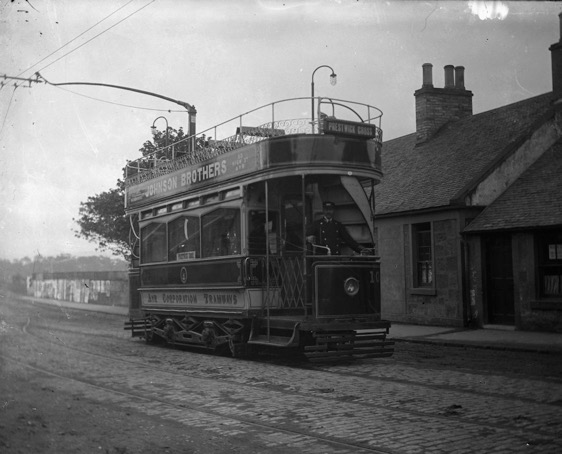
An Ayr Corporation Tramways motorman at the controls of what appears to be a brand-new Tramcar No 10 (possibly at Prestwick Toll loop), which would date the photograph to the tail end of 1901. Photo with kind permission of Kenny Baird.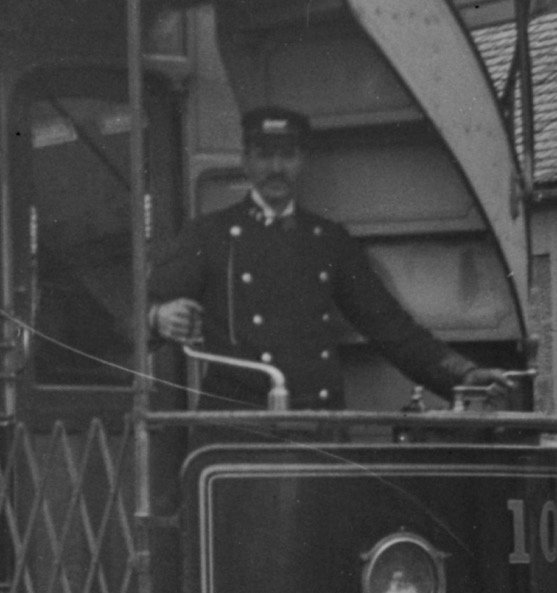
An enlargement of the above photograph, which although not sharp, clearly shows that the motorman is wearing a lancer-style tunic and a soft-topped peaked cap, the latter with a script-lettering grade badge. 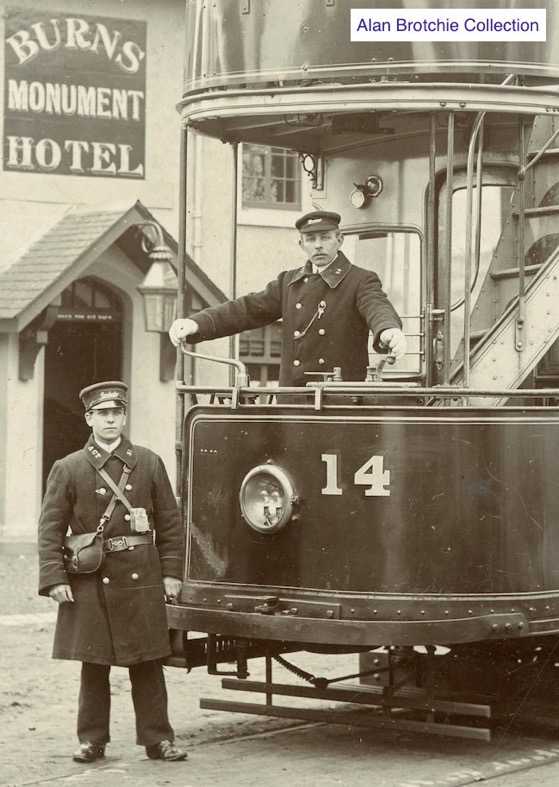
The crew of Tramcar No 14, which sports a sizeable scratch on the dash, pose for the cameraman outside the Burns Monument Hotel — photo undated, but probably taken in 1902 or 1903.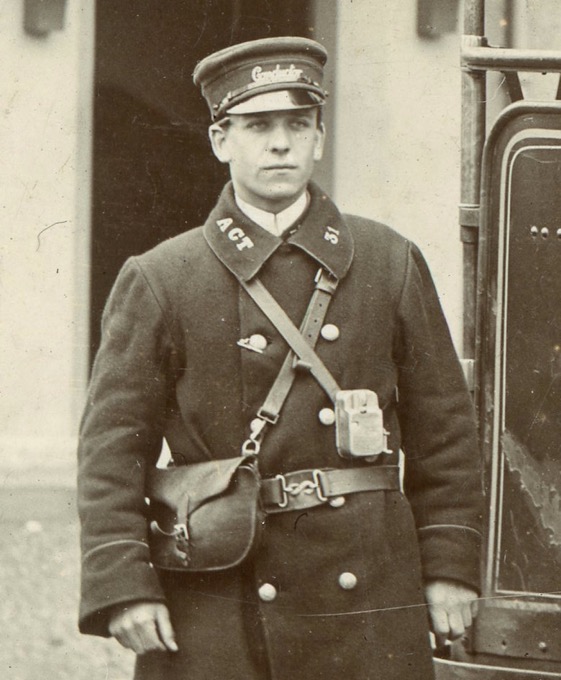
An enlargement of the above photograph showing the conductor (Employee No 31); his collar insignia, soft-topped cap and grade badge are easily discerned.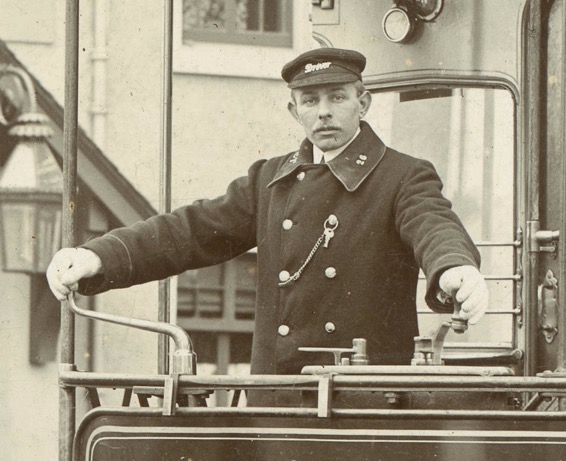
Another blow-up of the photograph above, this time showing the motorman (Employee No 26), who appears to be wearing white (or light coloured) woollen gloves.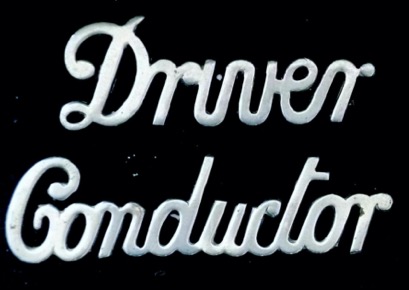
Standard script-lettering grade badges of the type used on the tramcar crew caps of Ayr Corporation Tramways — nickel. These badges were probably used for only the first one or two years of operation, before they were replaced by a titled cap badge (see below).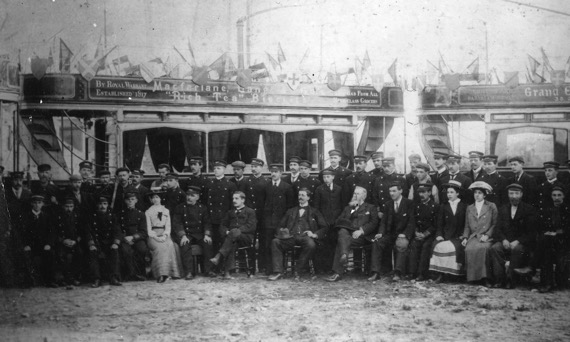
A rather odd assemblage of Ayr tramwaymen, officials and their wives, purportedly taken in 1902. Curiously, almost all the subjects appear to be staring to the left rather than at the camera, possibly indicating that someone was talking to them, perhaps giving a speech. Author's Collection.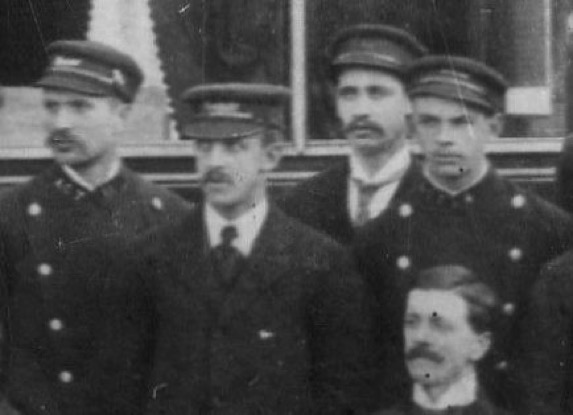
An enlargement of the above photograph showing a motorman (left), in lancer-style tunic, and a conductor (centre) in a plain, single-breasted jacket. The plain jackets were more than likely worn out of necessity (probably due to a shortage of uniforms) as other conductors in the photo are wearing lancer-style tunics.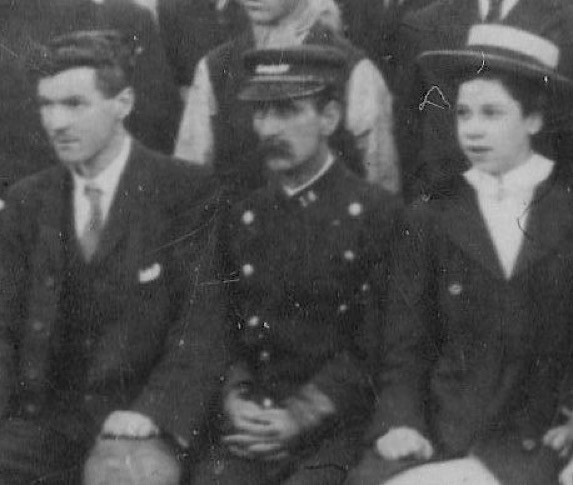
Another blow-up of the staff photo above showing a conductor (Employee No 14) in lancer-style tunic.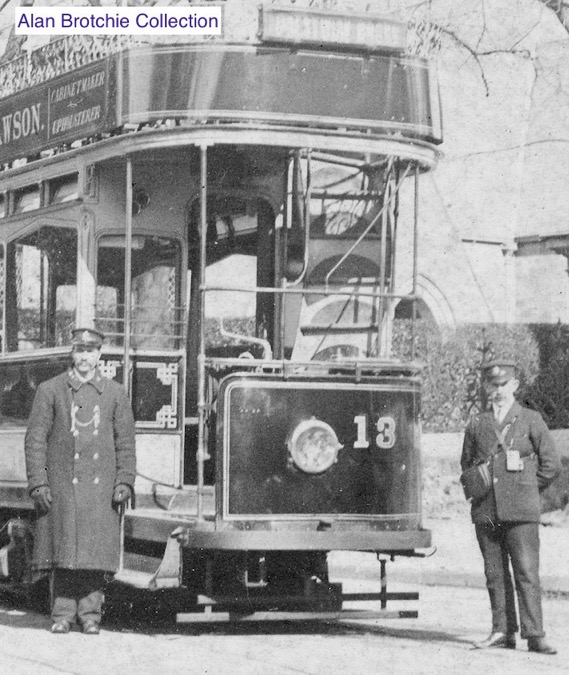
A relatively new-looking Tramcar No 13 outside St Leonard's Church — photo undated, but probably taken within the first year or two of opening. By this time the script-lettering grade badges had been replaced by a new cap badge (see below).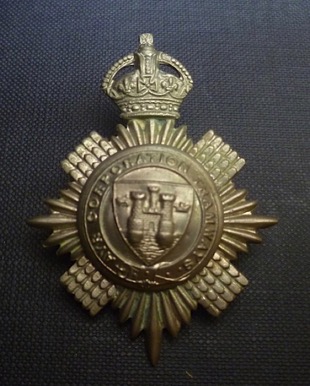
Ayr Corporation Tramways cap badge — nickel. These badges were probably worn from the mid-Edwardian era onwards. For a long time, it was thought that they were home-made contrivances given that the centre is a standard ACT button front, with the backing cross having the look of a Royal Scots regimental cap badge. Furthermore, I know of no other tramway badge that is topped by a king's crown, something that was normally characteristic of police badges, and in the example shown above, it has actually been reinforced by means of a clip and solder. Despite all these misgivings, photos clearly show them being worn, and the die for making them survives (see below), so they are indeed genuine. Author's Collection.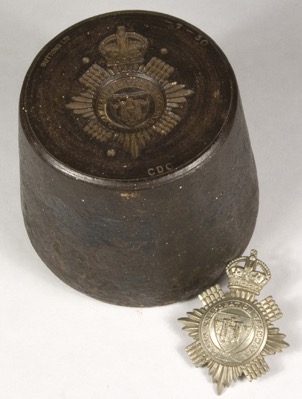
Ayr Corporation Tramways cap badge and die. Photo courtesy of South Ayrshire Council Museums and Galleries Service (see link)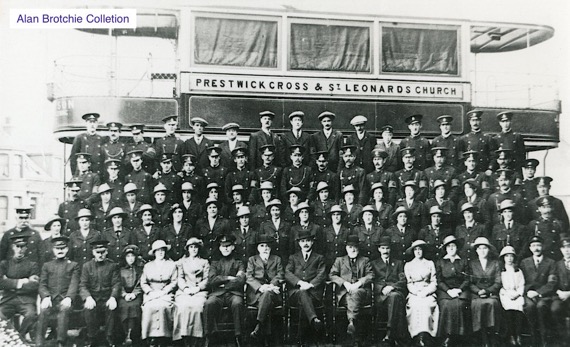
Presumably the entire staff (supplemented by officials' wives), assembled at Newton Park depot in 1916. The tramcar in the background is either No 23 or No 24, Ayr's first top-covered vehicles, both of which had been delivered the previous year.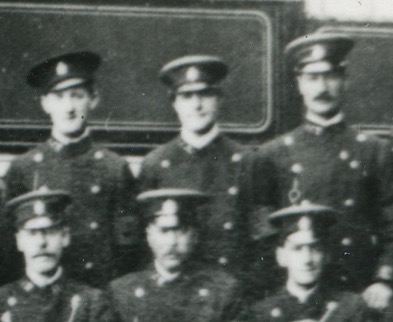
An enlargement of the above photograph showing some of the motormen and conductors, who by this time were clearly wearing more contemporary tensioned-crown peaked caps).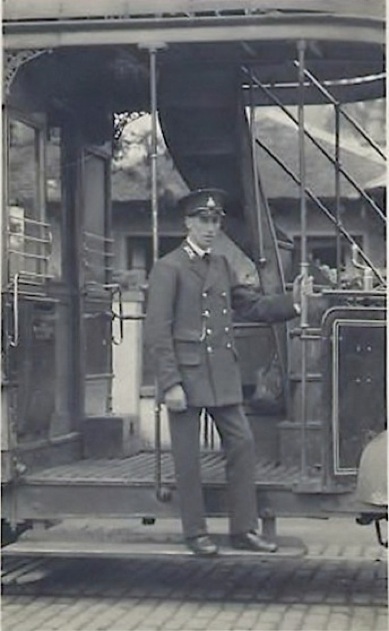
Ayr Corporation Tramways motorman — photo undated, but probably taken in the late 1920s. By this time the uniform had been changed to a smart double-breasted design with lapels. Stephen Howarth Collection.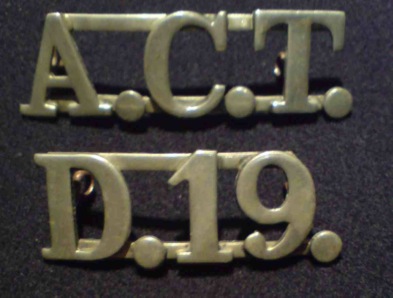
Probable Ayr Corporation Tramways collar initials — nickel. 'D' presumably stood for 'Driver'.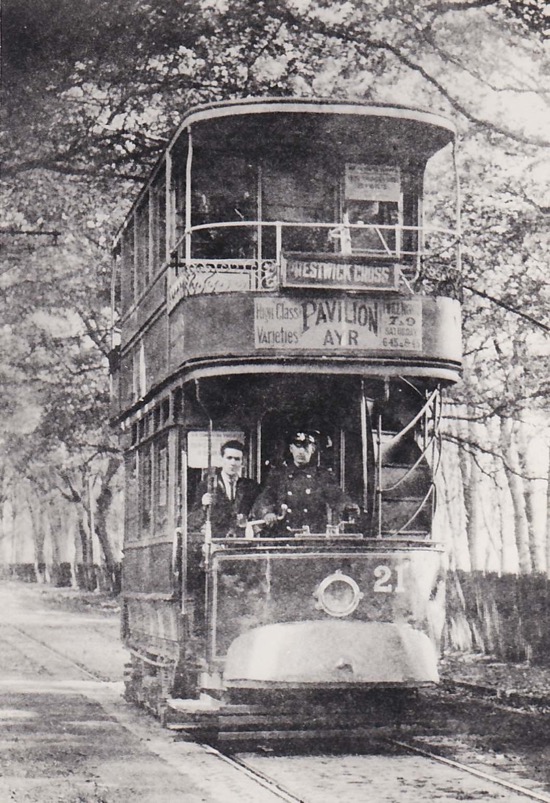
Tramcar No 21, bound for Prestwick Cross, on the long run through Rozelle Woods — photograph probably taken in the mid-to-late 1920s. The conductor, who is wearing civvies, is probably a university student, the ACT recruiting them in the summer months to deal with the heavy tourist loadings. Photo courtesy of David Sinclair.
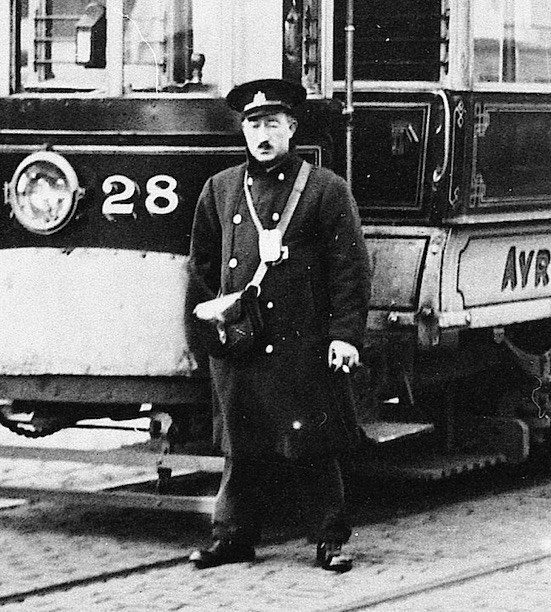
Tramcar No 28 with Motorman/Conductor T Sloan (No 28 was a one-man operated car) — photo undated, but probably taken in the last year of operation, 1931. Photo courtesy of Ayr Library.
Senior staff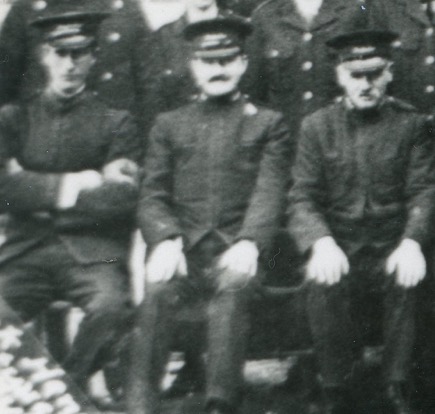
An enlargement of the 1916 staff photograph above showing three of the inspectors, all of whom are wearing typical 'tramway inspector' apparel.
Female staff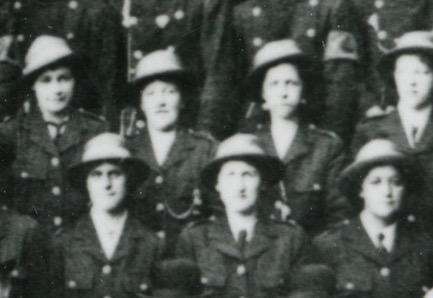
Another enlargement of the Great War staff photograph above showing seven of the female employees. It is unclear whether their bonnets bear cap badges or not.